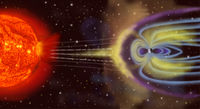
Photo from wikipedia
Understanding extreme space weather events is of paramount importance in efforts to protect technological systems in space and on the ground. Particularly in the thermosphere, the subsequent extreme magnetic storms… Click to show full abstract
Understanding extreme space weather events is of paramount importance in efforts to protect technological systems in space and on the ground. Particularly in the thermosphere, the subsequent extreme magnetic storms can pose serious threats to low Earth orbit (LEO) spacecraft by intensifying errors in orbit predictions. Extreme magnetic storms (minimum Dst ≤ −250 nT) are extremely rare: Only seven events occurred during the era of spacecraft with high‐level accelerometers such as CHAMP (CHAllenge Minisatellite Payload) and GRACE (Gravity Recovery And Climate experiment) and none with minimum Dst ≤ −500 nT, here termed magnetic superstorms. Therefore, current knowledge of thermospheric mass density response to superstorms is very limited. Thus, in order to advance this knowledge, four known magnetic superstorms in history, that is, events occurring before CHAMP's and GRACE's commission times, with complete data sets, are used to empirically estimate density enhancements and subsequent orbital drag. The November 2003 magnetic storm (minimum Dst = −422 nT), the most extreme event observed by both satellites, is used as the benchmark event. Results show that, as expected, orbital degradation is more severe for the most intense storms. Additionally, results clearly point out that the time duration of the storm is strongly associated with storm time orbital drag effects, being as important as or even more important than storm intensity itself. The most extreme storm time decays during CHAMP/GRACE‐like sample satellite orbits estimated for the March 1989 magnetic superstorm show that long‐lasting superstorms can have highly detrimental consequences for the orbital dynamics of satellites in LEO.
Journal Title: Space Weather
Year Published: 2020
Link to full text (if available)
Share on Social Media: Sign Up to like & get
recommendations!